N-BK7 Diffuse Reflectors, Protected Gold Coating

- Highly Diffusive in the IR Spectral Region
- Polished for Greater Uniformity than Sand Blasting
- Offered in 120, 220, 600, or 1500 Grit Polishes
DG10-600-M01
600 Grit
DG10-120-M01
120 Grit
DG10-1500-M01
1500 Grit
DG10-1500-M01 Reflecting
Collimated Light from a
L808P200 Laser Diode
Housed in an LDM21 Mount

Please Wait
| Table 1.1 Diffuser Selection Guide | |||
|---|---|---|---|
| Ground Glass Diffusers | |||
| Type | Material | Mounting, Coating | Operating Wavelength |
| Standard Diffusers | N-BK7 Substrate | Unmounted, Uncoated | 350 nm - 2.0 μm |
| Unmounted, AR Coated | 350 nm - 700 nm 650 nm - 1050 nm |
||
| Mounted, Uncoated | 350 nm - 2.0 µm | ||
| UVFS Substrate | Unmounted, Uncoated | 185 nm - 2.0 µm | |
| Diffuse Reflectors | N-BK7 Substrate | Unmounted, UV-Enhanced Aluminum Coated |
250 nm - 450 nm |
| Unmounted, Protected Silver Coated | 450 nm - 20 µm | ||
| Unmounted, Protected Gold Coated | 800 nm - 20 µm | ||
| Alignment Disks | |||
| Engineered Diffusers®* | |||
| Type | Material | Mounting, Coating | Operating Wavelength |
| Glass Diffusers | UVFS Substrate | Unmounted and Mounted, Uncoated | 400 nm - 700 nm |
| Polymer Diffusers | ZEONOR Substrate | Unmounted and Mounted, Uncoated | 400 nm - 700 nm |
| Diffuser Kits | |||
*Engineered Diffusers® is a registered trademark of VIAVI Solutions, Inc.
Features
- Ø1" Diffuse Reflectors
- Coated Surface has 120, 220, 600, or 1500 Grit
- Protected Gold HR Coating for the 800 nm to 20 µm Range
- Near-Gaussian Intensity Pattern at Small Angles of Incidence (AOIs) (See Figure 1.2)
- Clear Aperture: >90% Diameter
Thorlabs' Diffuse Reflectors are a solution for applications requiring a diffuse intensity pattern. The diffuse reflectors on this page have a protected gold coating deposited on the ground side of the optic. Unlike transmissive diffusers, these reflective diffusers are not susceptible to absorption losses and thus achieve >96% average reflectance in the 800 nm to 20 µm range. For other coating options, please see Table 1.1. These diffuse reflectors are produced from an N-BK7 substrate and are available in 120, 220, 600, and 1500 grit polishes.
Polished diffusers are advantageous over sand blasted diffusers as the surface has greater uniformity. The various grits provide a range of reflected intensity distributions. A coarser grind (e.g., 120) creates a wider diffusion pattern, while a finer grind (e.g., 1500) will provide a more localized one. The distribution of reflected light (AOI = 0°) for each diffuser is shown in Figure 1.2. To see how the distribution changes for AOIs of 15°, 30°, and 45°, see the Graphs tab. This sample data is typical and results may vary.
These diffuse reflectors have a thickness of 2.0 mm and thus are too thin to be used in our standard mirror mounts. Mounting options include our LMR1 Fixed Mount for Ø1" Optics, Ø1" lens tubes, or the KM100T Threaded Kinematic Mount. When mounting a diffuse reflector in a threaded optic mount, such as the LMR1, the ground and coated surface should face the lip of the mount and the retaining ring should secure the uncoated side, as shown in Figure 1.3. If the diffuse reflector is mounted facing the opposite direction, the reflective face will be recessed inside the mount and the housing will block a portion of the diffusely reflected light.
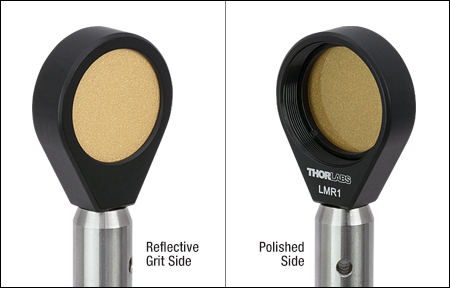
Click to Enlarge
Figure 1.3 Mount the optic with the input face towards the back of the LMR1 to prevent the obstruction of reflected beams.
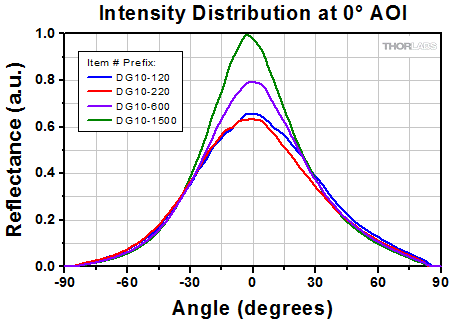
Click to Enlarge
Click Here for Raw Data
Figure 1.2 This typical data was taken with a light source at a 0° AOI. The curves are normalized to the peak measured value for the 1500 grit diffuser to highlight the differences in peak shape and intensity distribution between diffusers.
| Common Specifications | ||
|---|---|---|
| Coating on Grit Side | Protected Gold | |
| Average Reflectance of Coating (AOI = 0 to 45°) |
>96% from 800 nm to 20 µm | |
| Substrate | N-BK7 | |
| Diameter | 1.00" (25.4 mm) | |
| Thickness | 2.0 mm (0.08") | |
| Clear Aperture | >90% Diameter | |
| Parallelism | <3 arcmin | |
| Item # | Grit |
|---|---|
| DG10-120-M01 | 120 |
| DG10-220-M01 | 220 |
| DG10-600-M01 | 600 |
| DG10-1500-M01 | 1500 |
Below are the reflectance curves for the protected gold coating for S-polarized, P-polarized, and unpolarized light. A link to download the raw data is available below the graph. The shaded regions in the graphs denote the ranges over which we recommend using these diffuse reflectors. Please note that the reflectance outside of these bands is not as rigorously monitored in quality control, and can vary from lot to lot, especially in out-of-band regions where the reflectance is fluctuating or sloped.
For each grit available on this page, we have provided data showing the reflected intensity distribution for four AOIs. Intensity distributions were measured with a collimated source at a 0°, 15°, 30°, or 45° AOI. The gap in each curve represents the AOI of the light source. The intensity measurements were normalized by setting the peak measured value for the 1500 grit diffuser with the source at a 0° AOI equal to 1.
| Posted Comments: | |
user
(posted 2025-02-13 13:02:58.087) Thorlab团队您好,关于DG10-1500-M01的漫反射片的反射曲线,为什么只展示12AOI角度和45AOI角度,其他角度是否也与前两者相同?感谢解答! cdolbashian
(posted 2025-02-20 03:27:49.0) Translation: Hi Thorlabs team, regarding the reflection curve of the DG10-1500-M01's diffuse reflector, why is it only showing the 12AOI angle and 45AOI angle, and are the other angles the same as the first two? Thanks for the answer!
Thank you for reaching out to us with this inquiry. The reflection we present on the graphs tab, at the top of the page is simply for the gold coating (-M01) for a specular reflective substrate, likely a planar mirror. The data presented at 8° is nominally the same as normal incidence, while 45° is a more typically used angle. For other angles, I have contacted you directly to provide some internal test data. Andrew Boyd
(posted 2025-01-08 16:40:43.54) Dear Thorlabs,
Do you have data for the reflected intensity of these parts in "BSDF" form? Unless I'm misinterpreting it, the current normalised form of data makes it hard to radiometrically estimate the response of the part or model it in optical engineering software.
Many thanks
Andrew jdelia
(posted 2025-11-04 08:32:53.0) Thank you for contacting Thorlabs. This may be something we can help provide. We have reached out to you directly via email to clarify your inquiry and determine whether there are any specific diffuse reflectors you have in mind. Daniel Sox
(posted 2024-05-20 11:28:57.21) I would like to know the wavelength of the light source used to make the reflected intensity angular distribution graphs. If it is in the description I missed it.
Thanks,
Dan Sox cdolbashian
(posted 2024-06-04 01:42:29.0) Thank you for reaching out to us with this inquiry Dan. The light source used for this was a 633nm collimated laser. I have contacted you directly to discuss more specifics of the experimental design, if you would like. 隆之 島
(posted 2023-07-05 14:53:30.657) ご担当者様
産業技術総合研究所の島と申します。
DG10-220-M01を5点購入させて頂きました。
うち1点が本日納品されました。
拡散板の表面を見たところ、一部金属光沢のある
箇所があり、表面がやや不均一な状態となって
いました。
状況お知らせしておきます。
宜しくお願い致します。 cdolbashian
(posted 2023-07-06 08:55:49.0) Thank you for reaching out to us with this feedback. Our local team in Japan has reached out to you to discuss your inquiry. For future tech support inquiries, please feel free to contact your local office: sales@thorlabs.jp and they will connect you with a support specialist. Joris Baraillon
(posted 2022-12-19 15:32:13.223) Dear Thorlabs team,
I have three questions concerning the gold diffusers. We already have the 4 diffusers in our lab.
First question : Have you tested the influence of the source wavelength (in the mid-IR, between 3 and 12 µm) on the intensity distribution of the gold diffusers (DG10-120 to DG10-1500) ?
I expect the diffusing efficiency to be strongly dependent on the wavelength, especially for the smallest grit size (#1500).
Second question: could you confirm that the grit sizes are the following ?:
#120 : 109µm
#220 : 58µm
#600 : 9.3µm
#1500 : 2.0µm
Last question: do you have more details on the geometrical and optical characteristics of the diffuseurs (such as the correlation length) ?
I thank you in advance for your answer.
Best regards,
Joris Baraillon cdolbashian
(posted 2023-01-10 03:16:09.0) Thank you for reaching out to us with this inquiry Joris. I have some answers below.
1. We have not explicitly tested this, though we would tend to agree with you.
2. We cannot confirm this as we do not measure the specific size of the particles, and the standard we use is not always the same throughout the years. We characterize them by the grit # and the performance.
3. We do not have this data to share. Richard Staehr
(posted 2021-05-03 06:48:27.18) Dear Thorlabs Team, I'm interested in a DG10-220-M01. Is it possible to get such a protected gold coated diffuse reflector in square shape (similar to DG100X100-220, maybe even different sizes)?
You can reach out to me via Email.
Thanks,
Richard YLohia
(posted 2021-05-03 01:45:08.0) Hello Richard, thank you for contacting Thorlabs. Custom optics can be requested by clicking on the "Request Quote" button above or by emailing your local Thorlabs Tech Support team (in your case, europe@thorlabs.com). We will discuss the possibility of offering this directly. Heinz Falk
(posted 2019-03-18 07:52:49.31) Hello, we are using the DG10-220-M01 for calibrating a reflectometer. In your specification one finds the reflected intensity to be 94%. Does this mean, that the total reflected intensity observed in the half sphere amounts to 94% of the incident intensity? In this case, the intensity distribution at 0° AOI cannot hold for all grids.
Thank you for a clarification. nbayconich
(posted 2019-04-15 10:38:22.0) Thank you for your feedback regarding our DG10-220-M01 gold coated ground glass diffusers. Regarding your question about the reflected intensity would it be possible to clarify what you mean by the reflected intensity observed in the half sphere and where you found the reflected intensity to be 94%?
The 12 degree and 45 degree reflectance vs. wavelength plots are assuming a gold coated plano surface mirror with an incident source at either 12 or 45 degrees AOI. The Intensity distribution plots refer to the relative intensity measured on the actual gold coated reflective diffusers. All plots are normalized by setting the peak measured value for the 1500 grit diffuser with the source at 0 degrees AOI equal to 1. hoerner.thomas
(posted 2018-02-05 12:31:07.7) Dear Thorlabs Team,
I'm interested in a DG10-1500-M01 gold reflective ground glass diffuser, 1500 Grit. Is it possible to get such a diffuser with unprotected gold coating instead of protected gold? Could you contact me with a corresponding quotation?
Thanks
Thomas nbayconich
(posted 2018-02-06 03:38:45.0) Thank you for contacting Thorlabs. Yes we can provide these diffusers with un-protected gold coating. A techsupport representative will reach out to you directly with a quote. |
 Products Home
Products Home








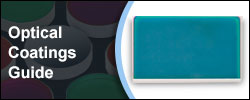

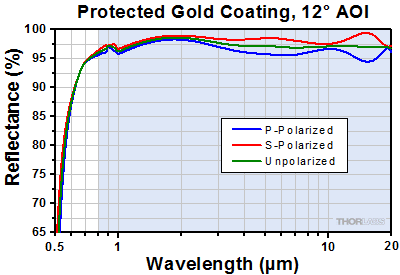
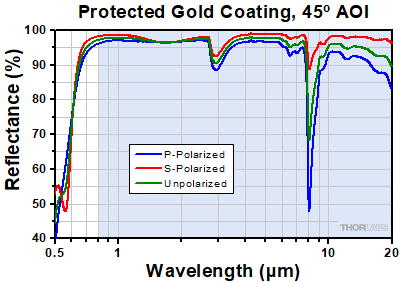
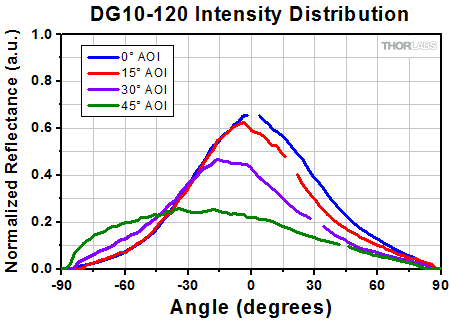
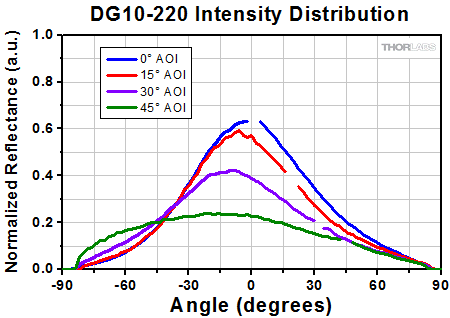
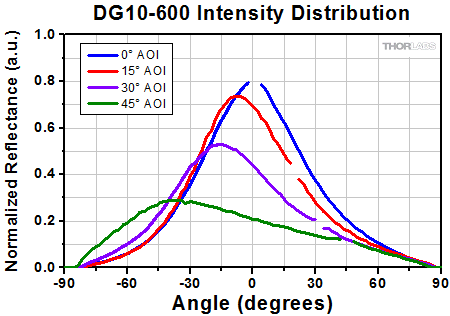
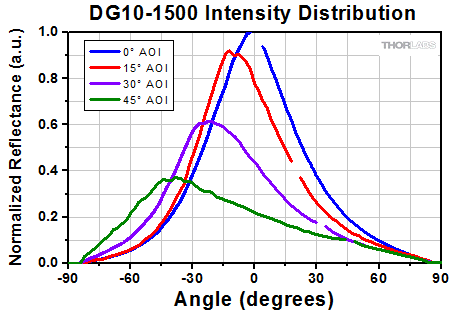

 N-BK7 Diffuse Reflectors, Protected Gold Coating
N-BK7 Diffuse Reflectors, Protected Gold Coating